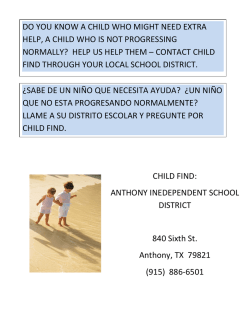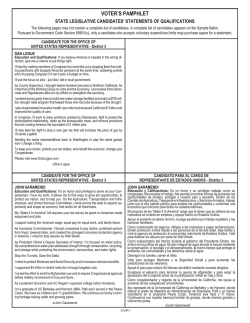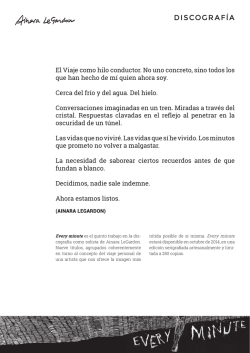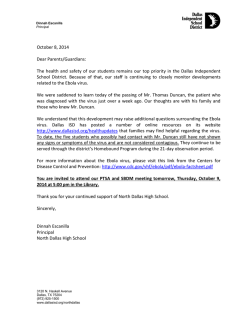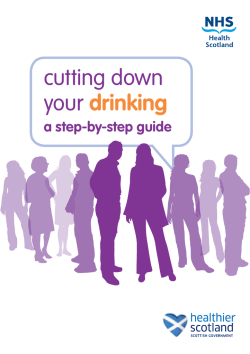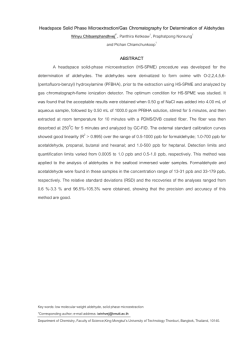
WHEN IN DROUGHT: - Otay Water District
2014 Consumer Confidence Report WHEN IN DROUGHT: Save Water Every Day, Every Way With summertime temperatures just weeks away, it is more important than ever for residents and businesses to take additional steps to conserve the region’s most precious natural resource. That is the goal behind the campaign “When in Drought: Save Every Day, Every Way,” launched by water agencies serving San Diego County. Most residents are aware of the statewide drought and have taken some action to reduce their water use, according to public opinion polling conducted by the San Diego County Water Authority. The research also shows that many people think they can do more to save water in light of the drought. Otay customers have already made large gains to boost water-use efficiency in recent years, but as water supplies are stretched thin across California, it is important for each of us to conserve more in case dry conditions continue into 2015. When in drought, we need to look for every way to save. In response to urgent calls from across the state, Otay and other Southern California water agencies have declared a Level 1 Drought Watch condition for our region and we are calling for voluntary conservation efforts such as: • Repairing leaks quickly • Washing paved surfaces only when necessary for health and safety • Eliminating inefficient landscape irrigation, such as runoff and overspray • Irrigating only during morning and evening hours • Using hoses with automatic shut-off valves for car washing and watering areas that aren’t on automated irrigation systems. In addition, restaurants can help by serving and refilling water only upon request, and hotels can help by offering guests the option of not laundering their linens and towels daily. Otay offers a range of resources for increasing water conservation at homes, businesses, homeowner’s associations and other organizations. They include rebates for purchasing water-efficient appliances and devices, incentives for replacing lawns with low-water landscapes, Water Smart landscape makeover classes, tips for trimming water use indoors and outdoors, and inspirational ideas for other water-wise improvements. For details, go to WaterSmartSD.org. San Diego County is not expected to experience water supply shortages this year because of regional investments of more than $2 billion in largescale water supply infrastructure, local water supply development projects, and regional water conservation efforts. The widespread adoption of wateruse efficiency practices has helped reduce Otay’s per capita water use by 26 percent between 2007 and 2013, exceeding state-mandated water-use efficiency targets of 20 percent by 2020. Despite these efforts, should current dry conditions extend into 2015 or the drought become more severe, additional conservation measures may be required. Before we get to that point, we want to thank you for your great work and support of water conservation. We also encourage everyone to take full advantage of the water conservation resources we have available for your home or business. For more information about regional water supply and demand, go to WheninDrought.org. Y O U R CON SUMER CONF IDENCE R E P OR T Otay Water District is pleased to provide you with your annual consumer confidence report. This report is a snapshot of last year’s water quality. Included are details about where your water comes from, what it contains and how it compares to state standards. The information included in this water quality report represents only a small fraction of what we do to ensure high-quality drinking water. Using one or more state-certified laboratories, we routinely scrutinize the water supply for an entire range of elements that have the potential to degrade the quality of your water. Only compounds detected in water sources are included in this report. As in years past, your tap water met all U.S. Environmental Protection Agency (USEPA) and state of California drinking water health standards. The Otay Water District vigilantly safeguards its water supplies and once again we are proud to report that our system has never exceeded a health-related maximum contaminant level or any other water quality standard. A B O U T THE OTAY WATER D ISTRIC T S AF E T Y Otay Water District is a California Special District established by the State Legislature in 1956 as a public water service provider. Today the District delivers potable water to more than 213,000 residents residing within a 125.5 square mile service territory that includes the communities of Spring Valley, La Presa, Rancho San Diego, and Jamul, as well as communities in the city of Chula Vista and the city of San Diego on Otay Mesa. In order to ensure that tap water is safe to drink, the USEPA and the state of California’s Department of Public Health (CDPH) prescribe regulations that limit the amount of certain contaminants in water provided by public water systems. CDPH regulations also establish limits for contaminants in bottled water that must provide the same protection for public health. Otay Water District imports an average of 87 percent of its water. Imported water is a blend of Colorado River water and State Water Project water. The District purchases treated water from the Metropolitan Water District of Southern California’s R.A. Skinner Treatment Plant (Skinner Plant), the County Water Authority’s Twin Oaks Valley Water Treatment Plant (Twin Oaks Plant), and from the Helix Water District’s R.M. Levy Treatment Plant (Helix Plant). S O U RCE WATER A SSESSMENTS The sources of water delivered by the Otay Water District include the Colorado River, the State Water Project, and local supplies. The agencies that supply treated drinking water to the Otay Water District, including the Metropolitan Water District of Southern California, San Diego County Water Authority, and the Helix Water District, are required to perform Source Water Assessments on their raw water supplies. If you would like copies of the Source Water Assessments, please contact Mr. Gary Stalker, System Operations Manager, at (619) 670-2228. Drinking water, including bottled water, may reasonably be expected to contain at least small amounts of some contaminants. The presence of contaminants does not necessarily indicate that water poses a health risk. More information about contaminants and potential health effects can be obtained by calling the USEPA’s Safe Drinking Water Hotline 1-800-426-4791 or online at http://water.epa.gov/drink/index.cfm. Some people may be more vulnerable to contaminants in drinking water than the general population. Immunocompromised persons such as persons with cancer undergoing chemotherapy, persons who have undergone organ transplants, people with HIV/AIDS or other immune system disorders, some elderly, and infants can be particularly at risk from infections. These people should seek advice about drinking water from their health care providers. USEPA/ Centers for Disease Control (CDC) guidelines on appropriate means to lessen the risk of infection by Cryptosporidium and other microbial contaminants are available from the Safe Drinking Water Hotline 1-800-426-4791. The sources of drinking water (both tap water and bottled water) include rivers, lakes, streams, ponds, reservoirs, springs, and wells. As water travels over the surface of the land or through the ground, it dissolves naturally occurring minerals and, in some cases, radioactive material, and can pick up substances resulting from the presence of animals or from human activity. www.otaywater.gov C O N TA M I N A N T S T H AT M AY B E P R E S E N T I N S O U R C E WAT E R I N C L U D E : • Microbial contaminants, such as viruses and bacteria that may come from sewage treatment plants, septic systems, agricultural livestock operations, and wildlife. • Inorganic contaminants, such as salts and metals, that can be naturally occurring or result from urban stormwater runoff, industrial or domestic wastewater discharges, oil and gas production, mining, or farming. • Pesticides and herbicides that may come from a variety of sources such as agriculture, urban stormwater runoff, and residential uses. • Organic chemical contaminants, including synthetic and volatile organic chemicals that are by-products of industrial processes and petroleum production, and can also come from gas stations, urban stormwater runoff, agricultural application, and septic systems. • Radioactive contaminants that can be naturally occurring or be the result of oil and gas production and mining activities. CONTAMINANTS THAT MAY BE PRESENT IN HOME PLUMBING SYSTEMS: • If present, elevated levels of lead can cause serious health problems, especially for pregnant women and young children. Lead in drinking water is primarily from materials and components associated with service lines and home plumbing. The Otay Water District is responsible for providing high quality drinking water, but cannot control the variety of materials used in plumbing components. When your water has been sitting for several hours, you can minimize the potential for lead exposure by flushing your tap for 30 seconds to 2 minutes before using water for drinking or cooking. If you are concerned about lead in your water, you may wish to have your water tested. Information on lead in drinking water, testing methods, and steps you can take to minimize exposure is available from the Safe Drinking Water Hotline at 1-800-426-4791 or at http://www.epa.gov/safewater/lead. ADDIT IONAL F L UOR IDE INF OR M AT ION AVAIL AB L E Otay Water District purchases drinking water from multiple sources. Our water wholesalers each add fluoride to the water supply in compliance with the California Fluoridation Act of 1995. Due to the blending of waters, which varies by region and time of year, fluoride concentrations may vary slightly between test stations. Otay Water District laboratory personnel closely monitor fluoride levels throughout its service area and posts this information to our website on a monthly basis. Please visit the Otay Water District’s website to view test results. For more information about fluoridation, oral health, and current issues, please visit: www.cdph.ca.gov/certlic/ drinkingwater/Pages/Fluoridation.aspx T HE T R UT H AB OUT TAP WAT E R Beliefs: Surveys have found that most consumers who drink bottled water do so because they enjoy its taste or its portable convenience. Others drink bottled water because they believe it to be more pure or safer than their tap water. The Truth: Did you know that the average bottle of water can cost up to 1,000 times more than tap water? Despite what its higher cost would lead us to believe, estimates are that 25-40 percent of the bottled water on the market is simply repackaged tap water. Tap water is regulated by the U.S. Environmental Protection Agency under the Safe Drinking Water Act, while bottled water is considered a food and is thus regulated by the Food and Drug Administration (FDA). Though some bottlers may voluntarily exceed FDA standards, both bottled water and public water supplies in the United States must meet similar standards for safe drinking water. For more information, visit www. DrinkTap.org. Your Options: During these economically sensitive times, it’s important to know that you have other, more affordable, options to bottled water. Chill a pitcher of tap water in your refrigerator. Using the chilled water pitcher with refillable water bottles or thermoses is environmentally friendly and allows for an inexpensive way to achieve refreshing portability. Residential water treatment devices. Another possibility is to install a home water filter system. The systems are convenient, easy to use, and enhance the taste of water. These systems achieve the same desired results, while still costing a fraction of the price of bottled water. For more information on California state-certified residential water treatment devices, click on the Devices and Machines link under the Certificates & Licenses tab of the California Department of Public Health website: www.cdph.ca.gov/certlic/device/pages/watertreatmentdevices.aspx 2013 WATER Q PARAMETER UNITS STATE OR FEDERAL MCL [MRDL] PHG (MCLG) [MRDLG] STATE DLR RANGE AVERAGE TWIN OAKS PLANT HELIX PLANT SKINNER PLANT MAJOR SOURCES IN DRINKING WATER PRIMARY STANDARDS — Mandatory Health-Related Standards CLARITY Combined Filter NTU 0.3 NA NA Highest 0.04 0.1 0.09 Effluent Turbidity % 95 (a) NA NA % < 0.3 100 100 100 Total Coliform Bacteria (b) % 5.0 0 NA Distribution System-wide: Otay Distribution System=0% Naturally present in the environment E. coli (c) (c) 0 NA Distribution System-wide: Otay Distribution System=0% Human and animal fecal waste ppb 1000 600 50 ppb 10 0.004 2 Soil runoff MICROBIOLOGICAL INORGANIC CHEMICALS Aluminum (d) Arsenic Fluoride Treatment-related ppm 2.0 1 0.1 Range ND 87 - 260 ND Average ND 179 ND Range 2 ND - 2.5 ND Average 2 ND ND Control Range 0.7 - 1.3 0.7 - 1.3 0.7 - 1.3 Optimal Level 0.8 0.8 0.8 Residue from water treatment process; natural deposits erosion Natural deposits erosion, glass and electronics production wastes Water additive Otay Distribution System Range: 0.6 - 0.9 Otay Distribution System Average: 0.7 RADIOLOGICALS Gross Alpha Particle Activity pCi/L 15 (0) 3 Gross Beta Particle Activity (e) pCi/L 50 (0) 4 pCi/L 20 0.43 1 Uranium Range ND 3.3 ND - 3 Average ND 3.3 ND Range ND ND ND - 5 Average ND ND ND 1.7 - 2.3 ND - 1 ND - 2 2.0 ND 1 Range Average Erosion of natural deposits Decay of natural and man-made deposits Erosion of natural deposits DISINFECTION BY-PRODUCTS, DISINFECTANT RESIDUALS, AND DISINFECTION BY-PRODUCTS PRECURSORS Total Trihalomethanes (TTHM) ppb Haloacetic Acids (five) (HAA5) ppb Total Chlorine Residual Bromate DBP Precursors Control (TOC) ppm Otay Distribution System Range = 27 - 55 Distribution System-wide: 80 (f) NA 1 (j) Otay Distribution System Range = 4.5 - 14 Distribution System-wide: 60 (f) NA By-product of drinking water chlorination Highest RAA = 63 1 (j) By-product of drinking water chlorination Highest RAA = 17 Otay Distribution System Range = ND - 3.7 Distribution System-wide: 4.0 (f) 4.0 NA ppb 10 (f) 0.1 5.0 ppm TT NA 0.30 Drinking water disinfectant added for treatment Highest RAA = 2.4 Range Average Range Average 1.4 - 4.9 ND 1.0 - 11 2.6 ND 5.9 2.0 - 2.5 2.2 - 2.3 2.1 - 2.4 2.3 2.2 2.2 By-product of drinking water ozonation Various natural and man-made sources SECONDARY STANDARDS — LEAD AND COPPER RULE — SAMPLED AT HOME TAP IN 2011 Copper (g) Lead (g) Aluminum (d) Chloride ppm AL=1.3 0.3 0.05 ppb AL=15 0.2 5 ppb 200 600 50 ppm 500 NA NA Internal corrosion of household pipes; erosion of natural deposits 0 sites above AL out of 78 sampled 90th percentile = 0.32 0 sites above AL out of 78 sampled Internal corrosion of household pipes; erosion of natural deposits 90th percentile = ND Range ND 87 - 260 ND Average ND 179 ND Range 86 75 - 91 83 - 86 Average 86 84 84 Residue from water treatment process; natural deposits erosion Runoff/leaching from natural deposits; seawater influence ABBREVIATIONS Al. . . . . . . . . . Aggressiveness Index AL. . . . . . . . . Action Level DBP. . . . . . . Disinfection By-Products DLR. . . . . . . . Detection Limits for Purposes of Reporting MCL. . . . . . . Maximum Contaminant Level MCLG. . . . . . Maximum Contaminant Level Goal MRDL. . . . . . Maximum Residual Disinfectant Level MRDLG. . . . Maximum Residual Disinfectant Level Goal N. . . . . . . . . . Nitrogen NA . . . . . . . . Not Applicable ND . . . . . . . . Not Detected NL. . . . . . . . . Notification Level NTU. . . . . . . Nephelometric Turbidity Units NR. . . . . . . . . Not Reported pCi/L. . . . . . . picoCuries per Liter PHG. . . . . . . Public Health Goal ppb. . . . . . . . parts per billion or micrograms per liter (µg/L) ppm . . . . . . . parts per million or milligrams per liter (mg/L) RAA. . . . . . . Running Annual Average TOC. . . . . . . . Total Organic Carbon TON. . . . . . . Threshold Odor Number TT. . . . . . . . . Treatment Technique µS/cm . . . . . microSiemen per centimeter DEFINITIONS • Maximum Contaminant Level (MCL): The highest level of a contaminant that is allowed in drinking water. Primary MCLs are set as close to the PHGs (or MCLGs) as is economically and technologically feasible. Secondary MCLs are set to protect the odor, taste, and appearance of drinking water. • Maximum Residual Disinfectant Level Goal (MRDLG): The level of a drinking water disinfectant below which there is no known or expected risk to health. MRDLGs do not reflect the benefits of the use of disinfectants to control microbial contaminants. • Maximum Contaminant Level Goal (MCLG): The level of a contaminant in drinking water below which there is no known or expected risk to health. MCLGs are set by the U.S. Environmental Protection Agency. • Notification Levels: Notification Levels are health-based advisory levels established by CDPH for chemicals in drinking water that lack maximum contaminant levels (MCLs). When chemicals are found at concentrations greater than their notification levels, certain requirements and recommendations apply. • Public Health Goal (PHG): The level of a contaminant in drinking water below which there is no known or expected risk to health. PHGs are set by the California Environmental Protection Agency. • Maximum Residual Disinfectant Level (MRDL): The highest level of a disinfectant allowed in drinking water. There is convincing evidence that addition of a disinfectant is necessary for control of microbial contaminants. • Treatment Technique (TT): A required process intended to reduce the level of a contaminant in drinking water. • Primary Drinking Water Standard (PDWS): MCLs and MRDLs for contaminants that affect health along with their monitoring and reporting requirements, and water treatment requirements. QUALITY DATA PARAMETER UNITS STATE OR FEDERAL MCL [MRDL] PHG (MCLG) [MRDLG] STATE DLR RANGE AVERAGE TWIN OAKS PLANT HELIX PLANT SKINNER PLANT Range ND ND 1-2 Average ND ND 2 Range 2 1-2 2 Average 2 1 2 MAJOR SOURCES IN DRINKING WATER SECONDARY STANDARDS — Aesthetic Standards Color Odor Threshold Specific Conductance Sulfate Total Dissolved Solids (TDS) Turbidity Units 15 NA NA TON 3 NA 1 µS/cm 1600 NA NA ppm 500 NA 0.5 ppm 1000 NA NA NTU 5 NA NA Range 840 600 - 790 830 - 870 Average 840 695 850 Range 170 83-160 170 - 180 Average 170 128 170 Range 490 340 - 470 500 - 520 Average 490 417 510 Otay Distribution System Range: 0.04 - 0.23 Naturally occurring organic materials Naturally-occurring organic materials Substances that form ions in water; seawater influence Runoff/leaching from natural deposits; industrial wastes Runoff/leaching from natural deposits; seawater influence Soil runoff Otay Distribution System Average: 0.06 FEDERAL UNREGULATED CONTAMINANTS MONITORING RULE (UCMR2) N-Nitrosodimethylamine (NDMA) ppb NA NA 0.002 Range ND ND ND - 0.004 Average ND ND ND By-product of drinking water chlorination; industrial processes FEDERAL UNREGULATED CONTAMINANTS MONITORING RULE (UCMR3 List 1 and List 2) Chlorate Molybdenum Strontium ppb NA NL=800 20 ppb NA NA NA ppb NA NA NA NA NA NA Otay Distribution System Range: 22 - 300 By-product of drinking water chlorination; industrial processes Otay Distribution System Average: 164 Otay Distribution System Range: 3.4 - 4.4 Naturally present in the environment Otay Distribution System Average: 3.8 Otay Distribution System Range: 760 - 920 Naturally present in the environment Otay Distribution System Average: 820 OTHER PARAMETERS - Chemical Alkalinity Boron Calcium Chlorate Corrosivity (h) (as Aggressiveness Index) Hardness (i) Magnesium pH Potassium Sodium ppm ppb NA NL=1000 100 ppm NA NA NA ppb NA NL=800 20 AI NA NA NA ppm ppm pH Units ppm ppm NA NA NA NA NA NA NA NA NA NA NA NA NA NA NA Range 110 85 - 100 72 - 130 Average 110 93 110 Range 120 140 120 Average 120 140 120 Range 57 34 - 51 58 - 59 Average 57 44 58 180 - 280 NA 51 Average 228 NA 51 Range 12 NR 12.4 - 12.5 Range Average 12 NR 12.4 Range 230 150 - 230 230 - 240 Average 230 190 230 Range 22 16 - 24 20 - 21 Average Range 22 21 20 7.5 - 8.8 7.9 - 8.2 8.2 Average 8.3 8.1 8.2 Range 4.1 3.5 - 4.6 3.9 - 4.3 Average 4.1 4.2 4.1 Range 82 62 - 87 78 - 81 Average 82 76 80 Runoff/leaching from natural deposits; industrial wastes By-product of drinking water chlorination; industrial processes Elemental balance in water; affected by temperature, other factors FOOTNOTES (a)The turbidity level of the filtered water shall be less than or equal to 0.3 NTU in 95% of the measurements taken each month and shall not exceed 1 NTU at any time. Turbidity is a measure of the cloudiness of the water and is an indicator of treatment performance. (b)Total coliform MCLs: No more than 5.0% of the monthly samples may be total coliformpositive. (c) E. coli MCL: The occurrence of two consecutive total coliform-positive samples, one of which contains E. coli, constitutes an acute MCL violation. The MCL was not violated. (d) Aluminum has both primary and secondary standards. (e)The gross beta particle activity MCL is 4 millirem/year annual dose equivalent to the total body or any internal organ. The screening level is 50 pCi/L. (f) Compliance based on running annual average. (g)Lead and copper are regulated as a Treatment Technique under the Lead and Copper Rule. It requires systems to take water samples at the consumers’ tap. The Action Levels, which trigger water systems into taking treatment steps if exceeded in more than 10% of the tap water samples, are 1.3 ppm for copper and 15 ppb for lead. (h)AI<10.0 = Highly aggressive and very corrosive water; AI>12.0 = Non-aggressive water; AI (10.0 -11.9 ) = Moderately aggressive water (i)Hardness can also be reported in grains per gallon. The distribution system average is 12.7 grains per gallon of hardness. (j)TTHM and HAA5 are combinations of several disinfection by-product compounds. The State DLRs are for the individual compounds. S U R EPORTE DE C O N F IAN ZA A L CO NSUMID OR El Distrito de Agua de Otay esta orgulloso de proporcionarle su reporte de confianza al consumidor. Este folleto es una fotografía de la calidad del agua del año pasado. Vienen incluidos los detalles de donde proviene el agua, que contiene y como se compara con los estándares del estado. La información incluida en este reporte de calidad del agua representa una pequeña fracción de lo que hacemos para asegurar agua potable de alta calidad. Usando laboratorios certificados por el estado, rutinariamente escudriñamos el suministro de agua por un completo rango de elementos que tienen el potencial de degradar la calidad de su agua. Así como en años pasados, su agua potable reunió todos los estándares de salud del EPA y el estado para agua potable. El Distrito de Agua de Otay de una manera vigilante salvaguarda los suministros de agua y una vez más estamos orgullosos de reportar que nuestro sistema nunca ha excedido un nivel máximo de contaminantes o ningún otro estándar de calidad del agua que impacte la salud. A C E R CA DEL D ISTRITO D E AG UA DE OTAY El Distrito de Agua de Otay es un Distrito especial de California establecido por la Legislatura del Estado en 1956 como proveedor de servicios de agua pública. Hoy, el Distrito suministra agua potable a más de 213,000 residentes que viven dentro de un territorio de 125.5 millas cuadradas que incluye las comunidades de Spring Valley, La Presa, Rancho San Diego y Jamul, así como las comunidades de la ciudad de Chula Vista y la ciudad de San Diego en Otay Mesa. El Distrito de Agua de Otay importa un promedio de 87 por ciento de su agua. El agua importada es una mezcla de agua del Río Colorado y del Proyecto de Agua del Estado. El Distrito compra agua tratada del Distrito Metropolitano de Agua de la Planta de Tratamiento R.A. Skinner del Sur de California (Planta Skinner), Planta de Tratamiento de Agua de de la Autoridad de Agua del Condado Twin Oaks Valley (Planta Twin Oaks), y de la Planta de Tratamiento de Agua R.M. Levy del Distrito de Agua de Helix (Planta Helix). U NA PLÁT ICA DIRECTA SOBRE A GUA Todos tienen interés en la calidad de su agua y algunos a veces preguntan, ¿Puedo sentirme seguro bebiendo agua de la llave? En el Condado de San Diego, la respuesta es sí. Sistemas Públicos de Agua, tales como los que operan el Distrito de Agua de Otay, deben cumplir con estándares para agua potable muy altos impuestos por la Agencia de Protección Ambiental de Estados Unidos o EPA, por sus siglas en inglés. El agua de la llave es regulada más rigurosamente que el agua embotellada y debe cumplir con todos los estándares de calidad de agua, tanto federales como estatales. Estas regulaciones son típicamente límites numéricos en las concentraciones, o cantidades de ciertos contaminantes en el agua. Para poder cumplir con estas regulaciones, los suministros de agua deben proporcionar un tratamiento específico, como desinfección y filtración, para asegurar que el agua sea potable. Si todavía estas preocupado o prefieres beber agua con un sabor diferente, puedes comprar agua embotellada, pero puede costar hasta mil veces más que el agua de la llave. Además, existen otras opciones más económicas que comprar agua embotellada. Otras opciones incluyen sistemas de filtración para la casa que son convenientes, mejoran el sabor, y solo cuestan una fracción del precio del agua embotellada. Los consumidores que deciden comprar una unidad de tratamiento de agua para sus casas deben leer cuidadosamente la información del producto para que comprendan lo que están comprando. También, deben seguir cuidadosamente las instrucciones de manufactura para la operación y mantenimiento del sistema, y recordar cambiar el filtro de una manera regular. www.otaywater.gov E VAL UAC IÓNE S DE F UE NT E S DE AGUA Las fuentes de agua suministradas por el Distrito de Agua de Otay incluyen el Río Colorado, el Proyecto de Agua del Estado, y los suministros locales. Las agencias que abastecen con agua potable al Distrito de Agua de Otay, incluyendo el Distrito Metropolitano de Agua del Sur de California, la Autoridad de Agua del Condado de San Diego y el Distrito de Agua de Helix, se les requiere llevar a cabo evaluaciones de sus fuentes de agua no potable. Si desea obtener copias de las evaluaciones del agua, favor de comunicarse con el Sr. Gary Stalker, Gerente de Sistemas de Operación, al (619) 670-2228. Información acerca de como minimizar el riesgo de infección por causa de Cryptosporidium u otros microorganismos contaminantes están disponibles en la Línea Directa de Agua Potable 1-800-426-4791. Este informe contiene información muy importante sobre su agua potable. Tradúzcalo o hable con alguien que lo entienda bien. Mahalaga ang impormasyong ito. Mangyaring ipasalin ito A D D I TION AL I N F O RM ATION Otay Water District appreciates your comments and active participation. If you have questions about the information contained in this report or testing processes, please contact Gary Stalker, System Operations Manager, at (619) 670-2228 or visit our website at www.otaywater.gov. You can also find helpful information by contacting the following agencies: California Department of Public Health Division of Drinking Water and Environmental Management (916) 558-1784 www.cdph.ca.gov/certlic/drinkingwater/Pages/ default.aspx United States Environmental Protection Agency Office of Water (4101 M) 1200 Pennsylvania Avenue, N.W. Washington, D.C. 20460 Safe Drinking Water Hotline: 1-800-426-4791 http://water.epa.gov/drink/index.cfm C ONS E R VAT ION - IT ’S E AS Y ! San Diego County has a semi-arid climate that receives only about 10 inches of rainfall per year. This does not provide enough water to meet local needs and the region must import much of its water from the Colorado River and Northern California. To maintain our quality of life, ensure adequate water supplies now and for future generations, and to save you money, San Diego County residents are encouraged to make a conscious effort to use our limited supply of water as efficiently as possible. The District offers a number of programs to save water both indoors and outdoors. For water wise landscaping tips, visit the Water Conservation Garden at Cuyamaca College or go to www.thegarden.org. For useful ways to conserve water around the house, visit our website at www.otaywater.gov and click on conservation. P UB L IC PAR T IC IPAT ION Otay Water District encourages public participation from the customers we serve. The board of directors generally meets on the first Wednesday of each month at 3:30 p.m. at District headquarters, 2554 Sweetwater Springs Blvd., Spring Valley, 91978. We encourage the public to attend these meetings. For directions, agendas or for further information, call (619) 670-2222 or visit our website at www.otaywater.gov. Otay Water District 2254 Sweetwater Springs Blvd. Spring Valley, CA 91978-2004 619-670-2222 [email protected] www.otaywater.gov Otay Water District Board of Directors Jose Lopez, President. . . . . . . . . . . . . . . . . . . . . . . . . . . . . . . . . . . . . . . . . Division 4 David Gonzalez, Vice President. . . . . . . . . . . . . . . . . . . . . . . . . . . . . . . . . . Division 2 Mitch Thompson, Treasurer . . . . . . . . . . . . . . . . . . . . . . . . . . . . . . . . . . . . Division 1 Gary Croucher, Director. . . . . . . . . . . . . . . . . . . . . . . . . . . . . . . . . . . . . . . . Division 3 Mark Robak, Director . . . . . . . . . . . . . . . . . . . . . . . . . . . . . . . . . . . . . . . . . Division 5 OTAY WATER DISTRICT 2254 Sweetwater Springs Blvd. Spring Valley, CA 91978-2004 619-670-2222 Pr-Srt Std. US Postage PAID Permit No. 700 San Diego CA www.otaywater.gov 2014 ConsumerConfidenceReport
© Copyright 2026
